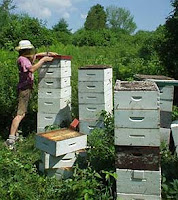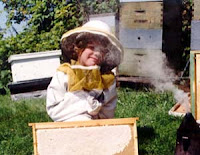by Tim McFarlin
Invasive Species! This phrase may bring to mind hordes of magenta spiked Loosestrife marauding their way through our northeastern wetlands or perhaps it’s the choking assault of the Kudzu in the south. Our landscape is thoroughly inundated with non-native species and growing by the year. Honey bees were brought to the Americas in the 1400’s, making them an invasive species. Do you think people are being invasive anywhere in the world now?
What is truly native? Is it defined by geography or chronology, or both? How long does a species have to be somewhere to attain native status? To me these debates are a waste of energy. We are all of the same world and we cannot halt the blending and mixing of it. So what can we do when the land as we know it is being overgrown? Rather than react and try to cut it out, poison it, or introduce another species to control, I feel that we should learn its history what it has to offer and establish a place for it in our lives. A perfect example is dandelion. Dandelion is cleansing to the liver and kidneys, the greens are nutrient dense, its value to our bodies cannot be elucidated here. So we harvest the plentiful, encourage the rare. Find out what the plants’ medicine or food value is, its utilitarian uses, what animals eat it, what insects live on it, how it smells, its beauty.

taking off honey that
the bears left July 31, 2003
I would ask for a moment that you suspend the negative thoughts that are associated with an invasive species. Purple Loosestrife, I learned from my Peterson guide, is useful as a gargle for sore throats, cleansing wounds, and good on stings we use it in our Throat Spray and Wound Wash).Through further research we learned a local herbalist had treated Irritated Bowel Syndrome and Chrone’s disease with it. Is it coincidence that the plants’ spurious growth comes at a time when these maladies are rampant in our society? There is much more to investigate. Purple Loosestrife also absorbs Nitrogen and Phosphorus from surface water. Purple Loosestrife is our number one honey plant in dry years, giving life to a wide range of pollinating sections. The bees work it as it has many blossoms per spike and flowers for weeks. As for Kudzu, the entire plant has many and varied medicinal uses. The Chinese have a rich history with this plant as it is native to Asia. There is a wealth of potential for this plant. One of my favorite little plants is Plantago major. This little invader is in our propolis salve it cleans wounds, stimulates healing, draws infection, the leaves are rich in vitamin, the seeds are nutritious, keeping bugs away due to its B vitamin content, and it flourishes in disturbed places where little else except other healing herbs grow.
Poison Ivy. What images does this name conjure in you? Itchy, blistery, to be avoided. Poison ivy grows in disturbed areas. Other vegetation soon begins growing amongst the ivy, animal trails weave their way through the now lush area, because people have stayed out, allowing the earth to heal itself. The poison ivy is the guardian of this healing. Poison Ivy is native as far as I know, and I only mention it here as an example of seeing beyond ourselves.
The Earth as a living matrix seeks its own vitality, repair, reproduction, and we (all life) are connected on levels beyond just the visually evident. If we look beyond the confines of our own constructs and the purely material, if we quiet our minds then we may see and feel without prejudice the essential value and beauty of all creatures. Indeed these “invasive” species are healing us and the land. If we stop reacting defensively, challenge our mental comfort zones and relinquish our prejudices there is no end to what we can learn, understand and ultimately live in harmony.
the bears and the bees
by Todd Hardie
He nourished him with honey from the rock …….. Deuteronomy 32:13
In the early days, bees made their homes in rocky places, and on hot days when the rocks got hot, honey would ooze out. Out of the hard places in life, we are given sweetness.
July 29, 2003
Much of our work these days is cleaning up after black bears devour our bees.
They scatter the homes of the bees, and after we find all of this, we walk around the bee yards and into the fields and woods beyond picking up the pieces. It takes hours, and at first, I felt so violated. The weeks that we pour into building and restoring equipment each year have felt so frustrating as the bears keep tearing apart the homes of our bees.
We try to save the bees, hoping that the queen and as much of the family as possible are in the boxes.
The other day, a bear(s) knocked over 13 colonies in the Plessis yard. This was a record. Usually they destroy one to three at a time.
If we come days later, many of the bees are still clinging onto their broken homes, faithfully clustered as a family, now exposed to the rain and sun.
We keep adding wires to the 
We are approaching 60 colonies of bees lost to the bears this season. The day was spent putting frames and boxes on the truck that had been dismantled by the bears in the last few months. When we went to the Herb bee yard, we found that two more colonies had been taken by the bears in the last three days. Here we learned that the batteries that we use must be recharged after five days or they lose enough of their ” sting” that bears walk right in. A few weeks earlier we did not understand how the bear was getting into the fenced in bee yard until we saw that the bear was climbing an ash tree next to the fence and then jumping over the hot wires to get into the bee yard.
I was weary and sad. All of the trials with the bears had worn me down, but this was naturally being merged into other information that I was continually gathering. I have increasingly seen that I have spread myself too thin and was trying to do much in order to make our beekeeping-agricultural business work, especially in a year of a light honey crop. The bears were giving me a message – let go of trying to work in so many wide-spread geographical areas in order to serve (metaphorically) Manhattan and Boston and everywhere in between and now work to serve a more regional and local market with honey and focus more on plant medicine.
A peace has settled over me. I see the bears now as our allies. They had helped me to see something that was much more important than all of the equipment and honey we had ” lost” to them this season and last.
I was so thankful.
December 5, 2003
Our relationship with the bears this year is just one part of the comprehensive changes at Honey Gardens Apiaries to be more sustainable and in relationship with our family and community. Thank you so much for your interest in and support of our bees and plants that allow us to do this work.